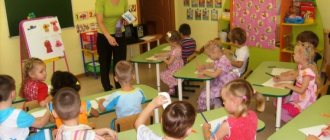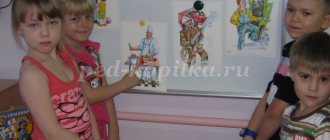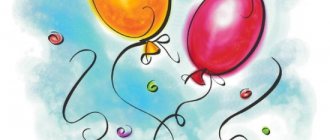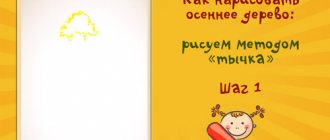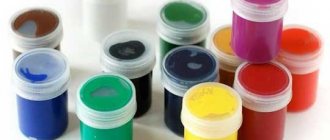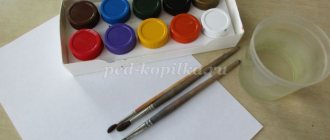Preparation for the art lesson “Simple and Golden Testicles” in the middle group
The lesson in question has a simple topic and task. To make it effective, the teacher carries out preliminary work, thinks through the structure of the lesson, and determines what is necessary for the practical part. Of course, taking into account the age and individual characteristics of the children. Educational activities bring positive emotions to children. For a positive creative experience, the child completes tasks that correspond to his abilities.
From a variety of materials and tools, the teacher selects the optimal ones for drawing for children 4–5 years old
Paints and base for painting
- Gouache - for drawing and coloring eggs. Watercolor - for drawing additional elements (nest, straw, grass).
- Medium thickness natural bristle brush. A thin brush will be needed if you intend to decorate testicles or paint other objects.
For painting in the middle group, it is better to use a medium-thick brush and rich paints - gouache - A4 sheet or half size: thick colored paper (office paper is not suitable),
- colored cardboard,
- blank tinted by the teacher (in watercolor),
- sheet with a printed image of a chicken or nest.
Children can draw testicles on a sheet with a picture of the Ryaba hen
Drawing technique
- Preliminary training in drawing an oval shape: children “draw” ovals in the air with a finger or a dry brush,
- chalk on a blackboard.
Pupils of the middle group develop the skill of drawing with a line and the ability to paint with a brush
For the lesson “Simple and Golden Testicles,” classical drawing techniques can be combined with non-traditional techniques. For example, grass or straw is depicted with finger paints. The nest can be depicted using thread printing, and the background can be painted with a foam sponge.
Combination with other types of artistic activities
Incorporating elements of modeling and appliqué into productive creativity in the classroom helps keep children’s attention in the work process. It is proposed to decorate the finished drawing of the testicles with plasticine elements: the sun, blades of grass, pebbles. Using applique, middle preschoolers can depict a nest or imitate the plumage of a chicken.
An ornament of applique details will decorate the pattern “Simple and Golden Testicles”
Multi-level tasks
An individual-personal approach to the lesson “Simple and Golden Testicles” should be implemented by complicating the task for children who actively demonstrate artistic talent:
- ask to draw not two eggs, but five gold and five white,
- give the task to draw a basket or nest for the testicles.
The teacher identifies which of the children can be given a more difficult task, and which needs help.
Place of the lesson “Simple and Golden Testicles” in the drawing card index
According to the art program in the middle group, the topic “Simple and Golden Testicles” is taught at the beginning of the school year. The teacher suggests remembering simple geometric shapes, thinking about which natural objects are oval. During the lesson, knowledge about the world around them expands and speech abilities develop: children answer questions, remember and recite the plot of a fairy tale.
Children 4–5 years old improve their skills in drawing lines and shading silhouettes. At this age, it is recommended to give a basic understanding of composition. Middle-aged preschoolers are unlikely to be interested in drawing two ovals on a piece of paper. Invite the children to create a fairy-tale picture: draw grass, glue a nest, and only then draw eggs in it.
It will be useful and interesting for children to diversify the composition with eggs
Pedagogical advice on organizing drawing classes in the middle group
Children of middle preschool age begin to show cognitive interest in creativity. Using various figures of speech, children learn to express their opinion regarding the picture they like and give basic arguments in favor of the artistic means that were used to convey the images.
The teacher begins to introduce children to folk toys: Dymkovo, Filimonov. They are so bright and expressive that they immediately attract children with their colorful images. In the middle group, classes in decorative drawing are introduced, during which, during a preliminary conversation, the teacher shows works of Russian traditional folk crafts. Children decorate doll dresses, scarves, aprons, sundresses for matryoshka dolls with different patterns. To develop children's imagination, it is advisable to cut out the outlines of a Dymkovo or Filimonovskaya toy from white cardboard or paper, which children place on sheets of paper decorated with patterns. Children will see an interesting painted toy, reminiscent of a folk one.
Before depicting an object, the teacher teaches children the ability to master its shape, study the image as a whole, without losing sight of the details important for this object. To add expressiveness to children's drawings, you can offer them paper of different shapes and colors. The teacher offers compositional and plot options, since for four-year-old children this task presents a certain difficulty, especially at the beginning of the school year. However, in the second half of the year, the teacher should gradually involve children in the process of coming up with the plot and compositional structure of the drawing. Thus, the teacher sets the task of motivating children to portray not only characters, but to supplement the plot with other details. For example, when drawing chickens, draw grass and flowers.
In drawing classes, you can use traditional drawing techniques using colored pencils, wax crayons, gouache, and watercolors. You can combine drawing media: watercolor and wax crayons. Among non-traditional techniques, finger painting and poking (for decorating testicles) may be interesting.
Develop interest in visual arts
The theme “Simple and Golden Eggs” allows you to develop interest in various types of visual activities, that is, along with drawing, the teacher can use modeling, for example, on the theme “The Ryaba Hen laid eggs”, and applique on the theme “Multi-colored Easter eggs”, “Let’s decorate” eggs for grandma." One of the most interesting non-traditional techniques is modeling from salt dough, which has a number of advantages over using plasticine. Salt dough is completely safe, molds well without sticking to your hands, does not stain the work surface and is easy to clean, and the main thing is that crafts made from such dough can be dried and painted during drawing classes or during joint activities between the teacher and children. The tradition of modeling from salt dough, already known in Rus', is being revived, providing opportunities for creativity.
The teacher can offer individual tasks to children who show special interest and ability in drawing. For example, decorate the testicles with a pattern using non-traditional drawing techniques (finger painting, painting with cotton swabs). You can also draw a chicken that has hatched from an egg using the palm painting technique. Children should find the idea of using semolina fascinating, drawing the outline of a testicle, then smearing it with glue and sprinkling it with semolina. This kind of assignment turns a learning session into a real creative process, and the children feel like artists.
Learn to come up with compositions
Composition plays an important role in the artistic development of children starting from early preschool age. In each subsequent age group, compositional solutions become more complex, an artistic concept appears, which the child tries to express through different types of visual activity. Children 4–5 years old need sensitive pedagogical guidance, that is, the teacher offers them various compositional solutions, creative tasks, coming up with something new each time. When children at the beginning of the school year master simple techniques for depicting objects of various shapes, then in a lesson on drawing simple and golden eggs it is difficult to talk about the large variability of compositional solutions. However, in the second half of the year, children are already mastering the skill of decorative drawing, mastering various techniques of brush painting, and we can talk about the complication of plot and compositional lines. One interesting option could be a collective composition of Easter eggs or multi-colored eggs in a basket. The composition can be complemented by a chicken or an Easter bunny.
Motivate creativity
At the beginning of the lesson, the teacher devotes several minutes to activating the cognitive activity of children, using various gaming techniques. By combining the rich world of play with the educational process, the teacher makes completing any task interesting. Thus, children should have play motivation. As a motivating start, you can use a shadow theater with the production of the fairy tale “Ryaba Hen”, a didactic game with your favorite characters. The teacher, together with the children, can act out a scene based on a fairy tale, or when a hen and chicks come to visit. Children will be interested, as they themselves will be involved in the production. The teacher can start the lesson by telling a fairy tale or reading a story, learning poetry, or using musical accompaniment.
Golden egg
We will need:
- Chicken egg
- Leggings or nylon tights (we won’t cook them, so nothing will happen to them)
- Flashlight (any one will do, even on a phone)
First, shine a flashlight on the egg to check its color. The egg should glow.
Tie a knot in the tights, place an egg in them and tie on the other side.
Next we have two
option:
First option
You simply spin the egg non-stop and swirl it for about 2 – 5 (the more the better) minutes.
In this case, you simply swap the whites and yolks.
.
Second option
You still spin the egg for about 2 minutes, but every 5 - 10 seconds you stop the rotation, sharply spreading your arms to the sides.
In this case, the yolk and white will mix
and the whole egg will turn out yellow.
Take the egg out of the tights and check it with a flashlight; it should no longer glow.
If it still glows, then the rotation procedure must be repeated.
Then just hard boil the egg (7 – 10 minutes). After cooking, place in cold water to remove the shell better.
That's all! If you followed the first option, you will get something like this:
And if according to the second, then something like this:
Liked? Subscribe to the channel, rate and share on social media. networks!
Summary of the lesson “Simple and golden testicles” in the middle group
Competent task setting and lesson planning contribute to the successful activities of the teacher and students.
A drawing lesson in the middle group lasts 20 minutes and has a clear structure:
- Organizing time.
- Motivating start to class.
- Practical work.
- Reflection (summarizing, discussion of work).
Showing and discussing drawings is a mandatory stage of the lesson in the middle group.
My daughter loved to draw from an early age. But one day I didn’t find her drawing at an exhibition of works. The group drew on the topic, but my daughter refused (according to the teacher). But to be honest, my daughter has lost interest... Don’t miss the introductory part of the classes, motivate your children - the artist in them will awaken!
Table: examples of a motivating start to a lesson
Video: cartoon based on the fairy tale “Hen Ryaba”
Table: lesson notes on artistic and aesthetic development in the middle group “Simple and golden testicles”
Lesson notes.
A drawing lesson on the topic “Simple and Golden Testicles” is usually held in mid-autumn and roughly correlates in time with the study of the topic on understanding the surrounding world “Poultry” . However, this topic can be timed to coincide with reading the fairy tale “The Cockerel and the Bean Seed” (adapted by O. Kapitsa).
Also, in the middle group, children can already be given initial ideas about the Easter holiday , especially since it falls in the second half of the year (when the students become more mature), and then drawing eggs will also become relevant and will take place in a pre-holiday atmosphere. You can offer to arrange a gift for your family in this way; in this case, the name of the activity can be varied, for example, “Easter egg”. At the same time, the additional use of modeling and appliqué elements to decorate a pre-painted egg will play a large role in artistic activity.
| Author's full name | Title of the abstract | |
| MDOU Mokeeevsky kindergarten | Drawing “Simple and Golden Egg” Educational objectives : continue to teach drawing oval-shaped objects, practice carefully painting over the image. Developmental tasks : consolidate knowledge of geometric shapes, in particular oval shapes, develop imaginative thinking and imagination. Educational objectives : to cultivate interest in living nature, in particular birds. Integration of educational areas : “Artistic creativity”, “Cognition”, “Communication”, “Socialization”, “Health”. Demonstration material: a variegated toy chicken, an egg. Handouts: white and yellow gouache, brushes, stands for brushes, jars of water, napkins, sheets of A4 paper tinted in a light shade, Preliminary work: looking at pictures of a chicken, conversations with preschoolers about the life of poultry, telling a fairy tale " Chicken Ryaba”, accompanied by a tabletop theater show, modeling eggs from plasticine. Progress of the lesson A surprise moment. The teacher tells the children that today a chicken came to visit them - he shows a toy chicken with a motley color and asks what its name might be. A detailed description of the appearance of the Pestrushka chicken: a small red comb, a beard of the same color, a yellow beak, wings, paws, a small tail. The guys answer the question: why does a bird need a beak? Children's reasoning on the topic: why chicken is a poultry. Preschoolers imitate the voice of a chicken. Next, the teacher smoothly moves on to the fairy tale “Ryaba the Hen,” which the children had already become acquainted with in the previous group. This is where the motivation for the activity comes from: I feel sorry for the grandparents and the chicken, I need to help them - to depict testicles - simple and golden. Examining a real chicken egg and its shape, the teacher draws attention to the fact that one end is sharp and the other is blunt. Together with the children, the teacher draws the outline of an egg in the air with his finger. Physical education (this is relevant, since the mouse is also present in the fairy tale “Ryaba Hen”) The mice came out one day to see what time it was. One, two, three, four, The mice pulled the weights. Suddenly there was a terrible ringing sound, the mice ran away. | walking in place, turning left and right, clapping your hands above your head, hands up and squatting with your hands down - “pulled the weights” clapping in front of you, running to your place |
The teacher demonstrates on the board techniques for depicting a testicle, emphasizing that the hand moves the hand without stopping. If at first the line is drawn rounded, then it is slightly stretched, after which it is rounded again, but less, so that a narrowed tip is obtained. The teacher calls two or three children to depict an egg at the board. Independent work of preschoolers. During the activity, the teacher makes sure that everyone does it right and guides the children. Exhibition of works on the board. The teacher asks the children to show the egg that most closely resembles the real one. Chicken Pestrushka praises all the pupils, says that she is going to her home, to her grandparents, and taking the testicles with her.
Nikolaeva O.S. “Testicles in the nest” (collective painting of wooden eggs) A moment is used as motivation for productive activity: a sad hen came to visit the children, who reported that she had a problem - the testicles that she laid in her cozy nest , rolled in different directions and got lost. The teacher and children feel very sorry for the chicken. Of course, you need to help her - paint the wooden eggs white and gold and put them in the nest. The teacher has prepared a wicker nest in advance, covered with green corrugated paper (grass). Each child is offered a wooden egg, which he or she chooses to paint with white or yellow gouache. After drying, all the eggs are put into a nest to please the chicken. E. S. Zinchenko “Painting an Easter Egg” This activity is already distinguished by broader educational goals - a respectful attitude towards the culture and Orthodox traditions of the Russian people is formed, love and kindness towards the world around us is cultivated. At the beginning of the lesson, the teacher informs about the imminent arrival of the Great Easter holiday, which has been celebrated for more than 2000 years. The teacher, in a form that children can understand, talks about the religious significance of this holiday. It would be very appropriate at this stage to include a soundtrack of bell ringing in the lesson. Gradually, the teacher moves on to a story about the tradition of treating friends with painted Easter eggs on Easter. Since such a gift is a sign of respect for people, children are encouraged to make such a gift with their own hands for their mom and dad or other relatives. This will be a motivation for preschoolers (who simply love to make similar gifts for their relatives with their own hands). The teacher shows the children what patterns can be painted on an egg and also informs them about their symbolic meaning. Samples of ornaments hang on the board. It would be interesting to include elements of modeling and appliqué in such activities. For example, patterns on a pre-colored egg can be formed using plasticine printing. An interesting physical education course is held to help you get to work in a good moodPhoto gallery of examples of finished compositions.
A drawing lesson in the middle group “Simple and Golden Testicles” is a rather interesting topic. Despite its apparent simplicity, it makes it possible to consolidate children’s theoretical knowledge about poultry and recall the plot of a familiar fairy tale. A variation on the Easter theme is very exciting and educationally useful. Such productive activities allow you to consolidate the ability to draw narrow lines with a brush and rhythmically apply wide strokes without going beyond the contour of the image. In addition, if children additionally decorate painted eggs, they develop imagination and the ability to harmoniously arrange an image on paper.
- Author: Larisa Morozova
Higher philological education. Experience as a proofreader, editor, website maintenance, teaching experience (first category). Rate this article: (3 votes, average: 5 out of 5)
Tags:
